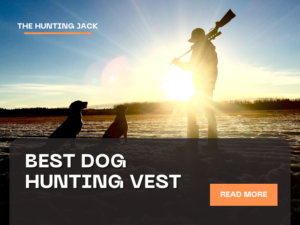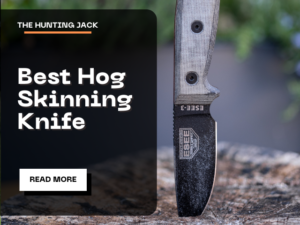The thrill of the hunt always leads to a euphoric moment when you drop that deer. You may have to follow its blood trail first, but excitement is tangible in the air, and everyone present is showing it. But this only lasts so long before the real work begins and the head-scratching starts. How are we going to get this perfect specimen back to camp?
Sometimes it’s a breeze, but sometimes it takes concerted and extreme effort. This can depend on how far you are from your camp or truck. Either way, you must find the best way to carry your deer out of the woods.
Depending on the circumstances, you’ve got a few choices.
Table of Contents
ToggleField Dressing
Different methods are used in various regions of the US. First things first: clean and cool a deer at the kill site directly after tagging it. Field dressing prevents the venison spoiling and reduces the deer’s body mass. You’re likely dragging a quarter less carcass weight if you clean out the stomach on-site.
Head First
You should always drag a deer by the antlers or front legs. After all, every animal walks forwards. You will encounter more resistance if you pull a deer by its hind legs as the fur always grows in the other direction.
Never mind if you decide to tan its hide or mount your deer later, you’ll have a better pelt to work with. Dragging a deer by its back legs could result in damaging the coat.
Get a Grip
So you want to pull your deer back to camp physically? If you’ve landed yourself a buck, you’re in luck, as it’s got ready-made places to grip with its antlers. Lazier hunters wait for bucks as opposed to does for this reason alone.
If you believe that last statement, you’re more easily led than the deer was in your sights! Any deer is a prize, and no good hunter will turn a kill shot down based on whether the deer has antlers!
A deer with antlers certainly makes the hauling job more straightforward, though. You and a buddy can grip a side each and start pulling. A deer drag is not easy, so it might help to strap the front legs and the antlers together. This creates a more streamlined effect and minimizes the legs snagging on the undergrowth as you move.
Harness Your Power
The majority of deer hunters will get high up to hunt. If you’re in a tree stand plying your trade, you’ll likely wear a harness for safety. Besides possibly saving your life, this harness also makes a fantastic deer-hauling tool. Connect the rope around your deer’s head or antlers; make necessary length adjustments, and pull. It’s that simple.
Ensure the tether length is such that the deer’s head is slightly above ground level. Remember that you may want to mount your buck later, so don’t risk ruining it.
Handle the Task
Perhaps you’ve got space in your backpack for a handle of some kind? I’ve always found room for some rope, a sawed-down broom handle, or a piece of wood or metal with a similar diameter.
If you bind the rope to your handle, you’ll have an excellent tool for a deer drag. You could even premake it before the trip by drilling a hole or two and threading the rope through. Whatever the case, design it in a way that suits you.
Slay Then Sleigh
A plastic sled makes hauling a dead deer so much easier, especially if it’s a monster mule deer and you’ve got a long way home. In snow country, this works even better, but in more hardy terrain, it still takes much weight off dragging. Prepare by making a few holes on each side of the sled to secure the carcass and start pulling. Once again, two draggers are better than one!
Start the Cart
Although a plastic sled makes your trip back to the truck or camp easier, another way might become your only option once you’ve used it. A deer cart folds to use like a backpack. When you’ve assembled it and attached the wheels (yes, wheels), load your deer onto the deer cart and wheel it home like a wheelbarrow. Deer hunters love these kinds of toys.
Make no mistake, you’re still going to sweat and count down the miles you have left to travel, but your buck will be off the ground and easier to manage. A deer cart makes the latter part of a hunting trip easier unless you’ve got a mountain bike.
Ride on Time
There are those hunts when hunt zones are easily accessible, with drivable tracks and even roads nearby. It doesn’t always happen, so be thankful for the opportunity to hunt in these locations.
When you’re lucky enough and can park your truck or mountain bike nearby, it means only dragging your deer out of the woods to the vehicle. Then you can load the buck on the truck or four-wheeler and hit the nearest road. Deer hunting can be easy sometimes!
Divide and Conquer
Of course, you’ll have those other times too. I’m talking about the ones where deer hunting isn’t easy at all. Perhaps the terrain is wet or wild and rugged. With the nearest road miles away, there’s no chance of getting wheeled vehicles close to the hunt site.
If you’re in a state where you’re permitted to quarter your deer on-site, this may be your best option. Check the local regulations of the state you’re in, though, as if the law doesn’t allow it, you’re in for a long and arduous dragging session!
If you’re allowed to, it will make sense to quarter the deer right there and then, and pack the meat into game bags for much easier transportation. The pack type isn’t that important, as any packing will work better than the alternative.
FAQs
How do you use a pack frame for carrying deer meat?
After packing your game bags with your quartered deer inside, a pack frame evenly distributes the load. Most of the burden will be on your hips and supported by your legs, making carrying your deer quarters more manageable.
What is a good tip when transporting a deer on a truck?
If you’ve got a way to go, keeping the deer’s body cavity open makes sense to make for quicker cooling.
What should you do if you need to drag a deer far?
You should always have a rope in your pack. If you haven’t brought anything else to make the deer drag easier, find a sturdy branch or something else to which you can tie the rope. Secure the other end of the rope to the deer’s head and make a plan, MacGyver-style.
In Closing
There are many ways to get a deer home. What not to do when deer hunting, however, is think you shouldn’t venture too far out, as getting a deer back will be too far or difficult. The retrieval and dragging process is an essential part of the hunt. Sometimes it’s easier; others, it’s a test of strength and character.
If you allow worry about getting your kill back to camp to get the better of you, you’ll always regret passing up the shot in the end.
If you’ve enjoyed this guide, my tips and advice on how the moon affects deer movement might also be of interest.



